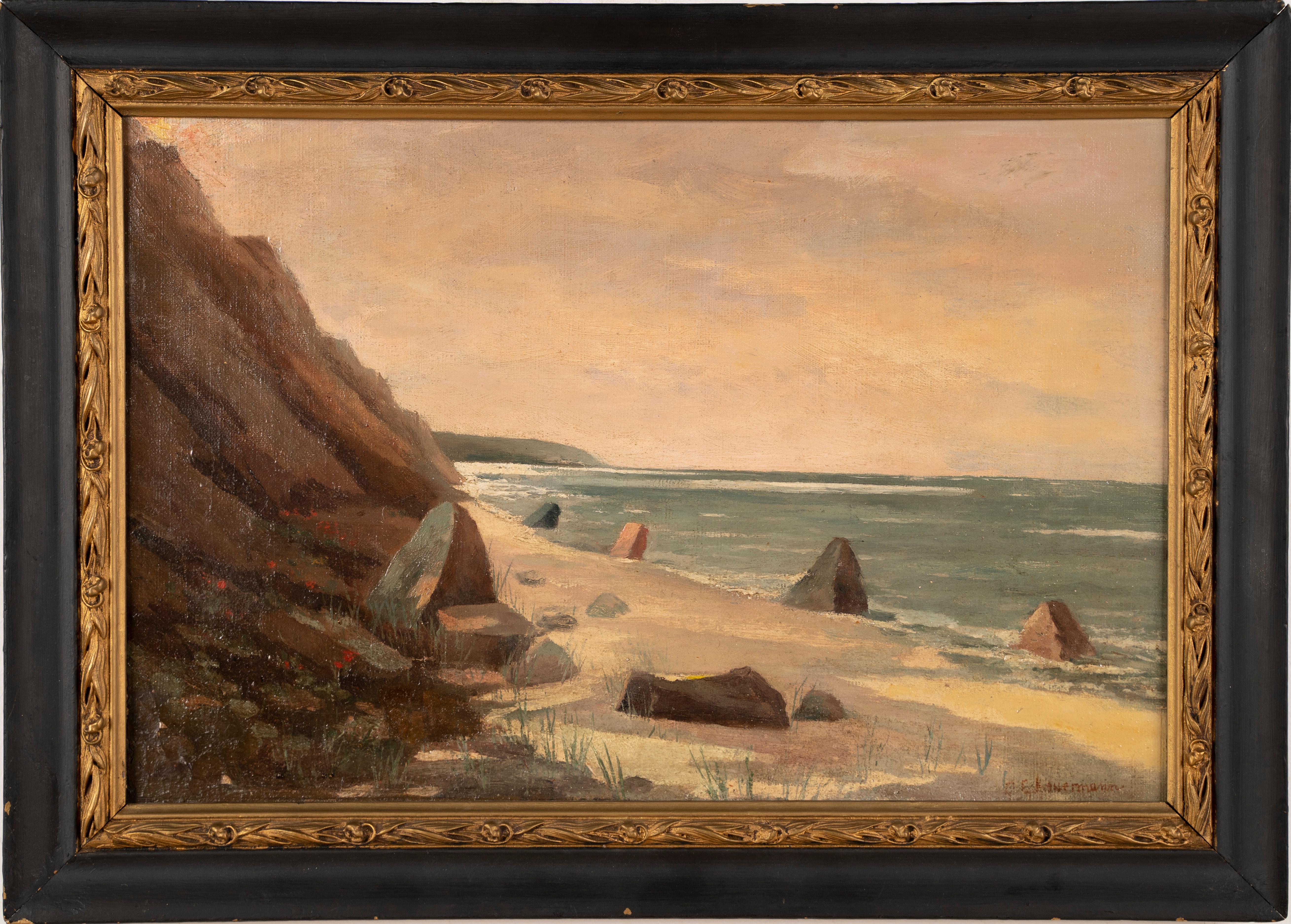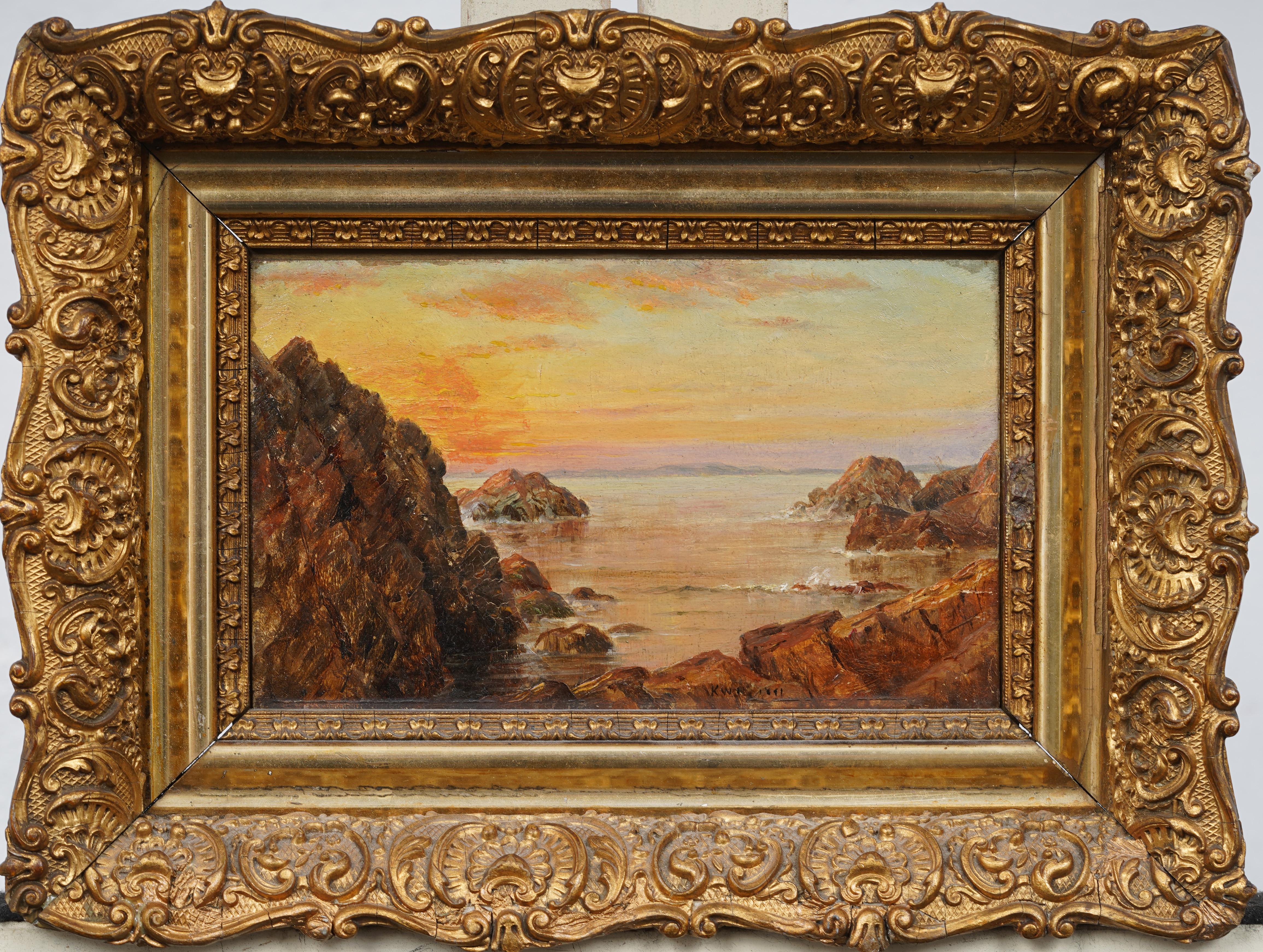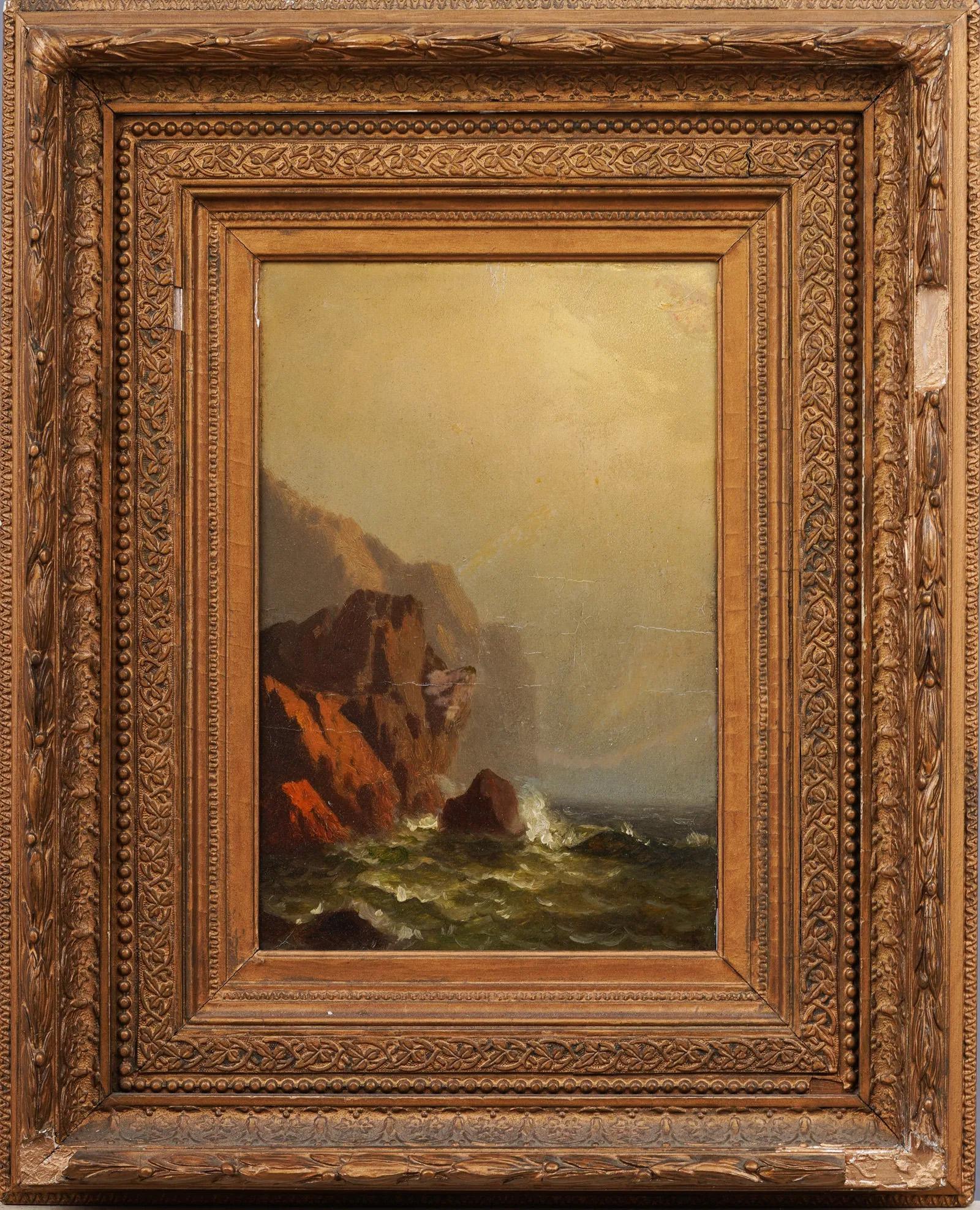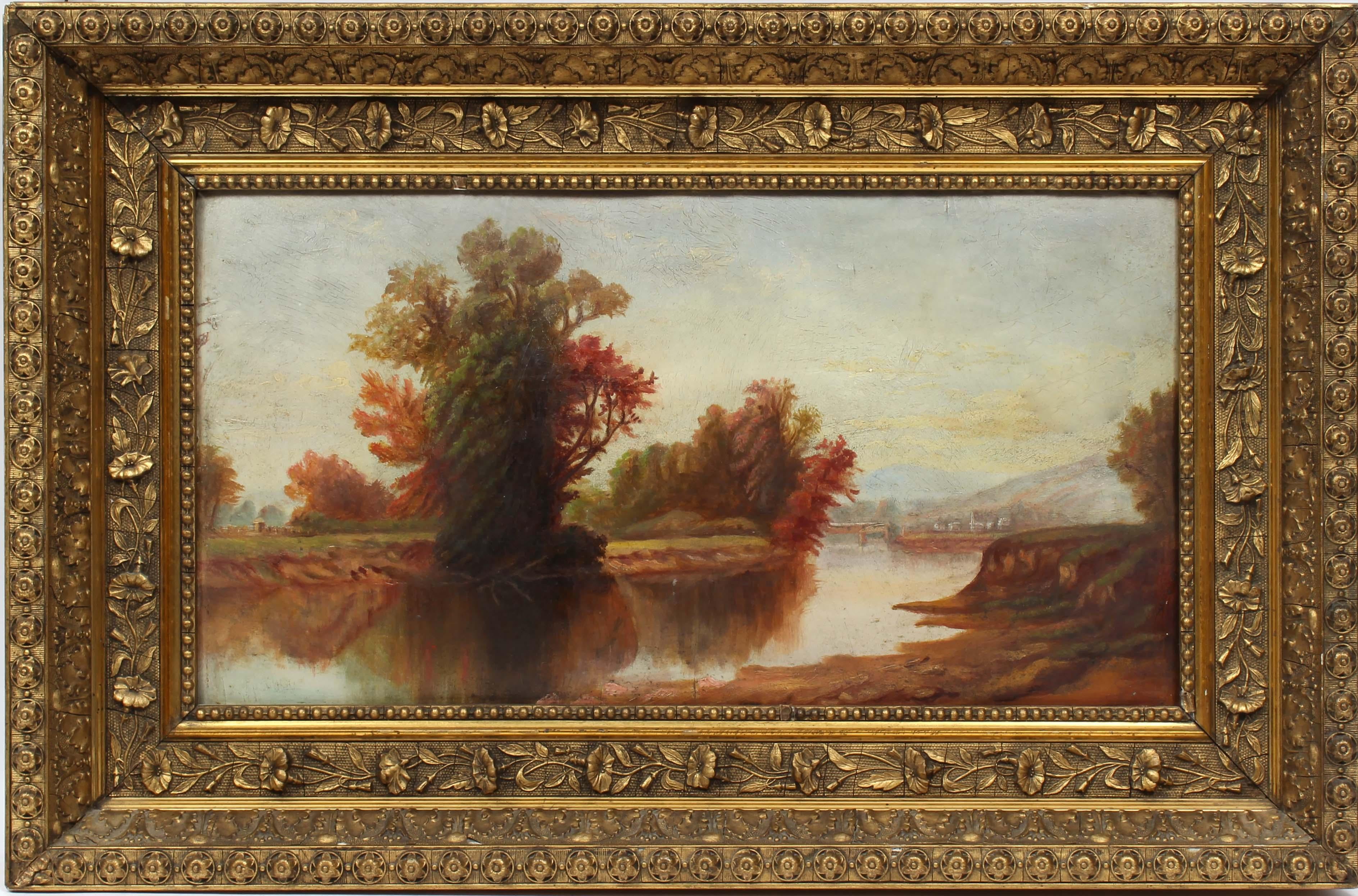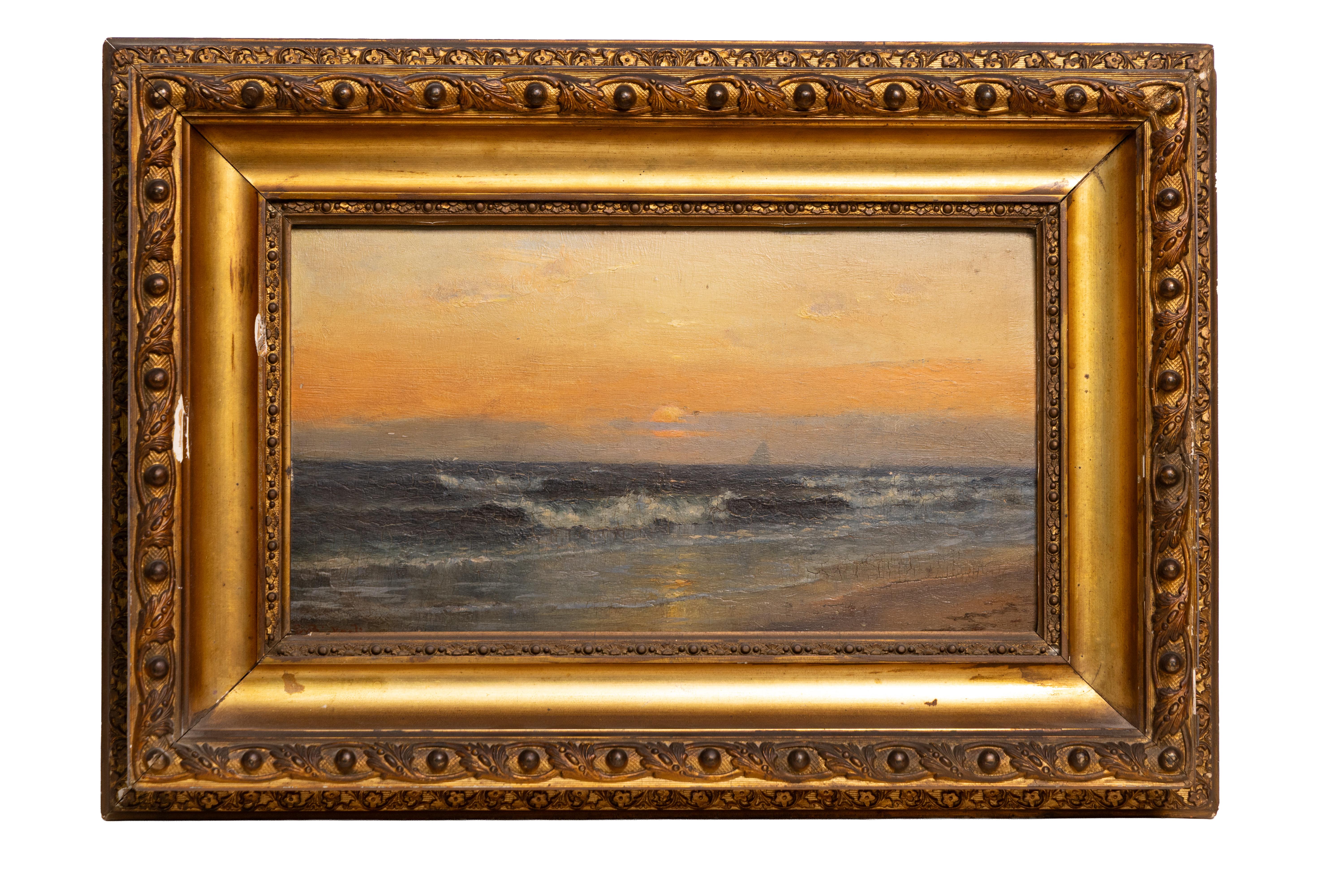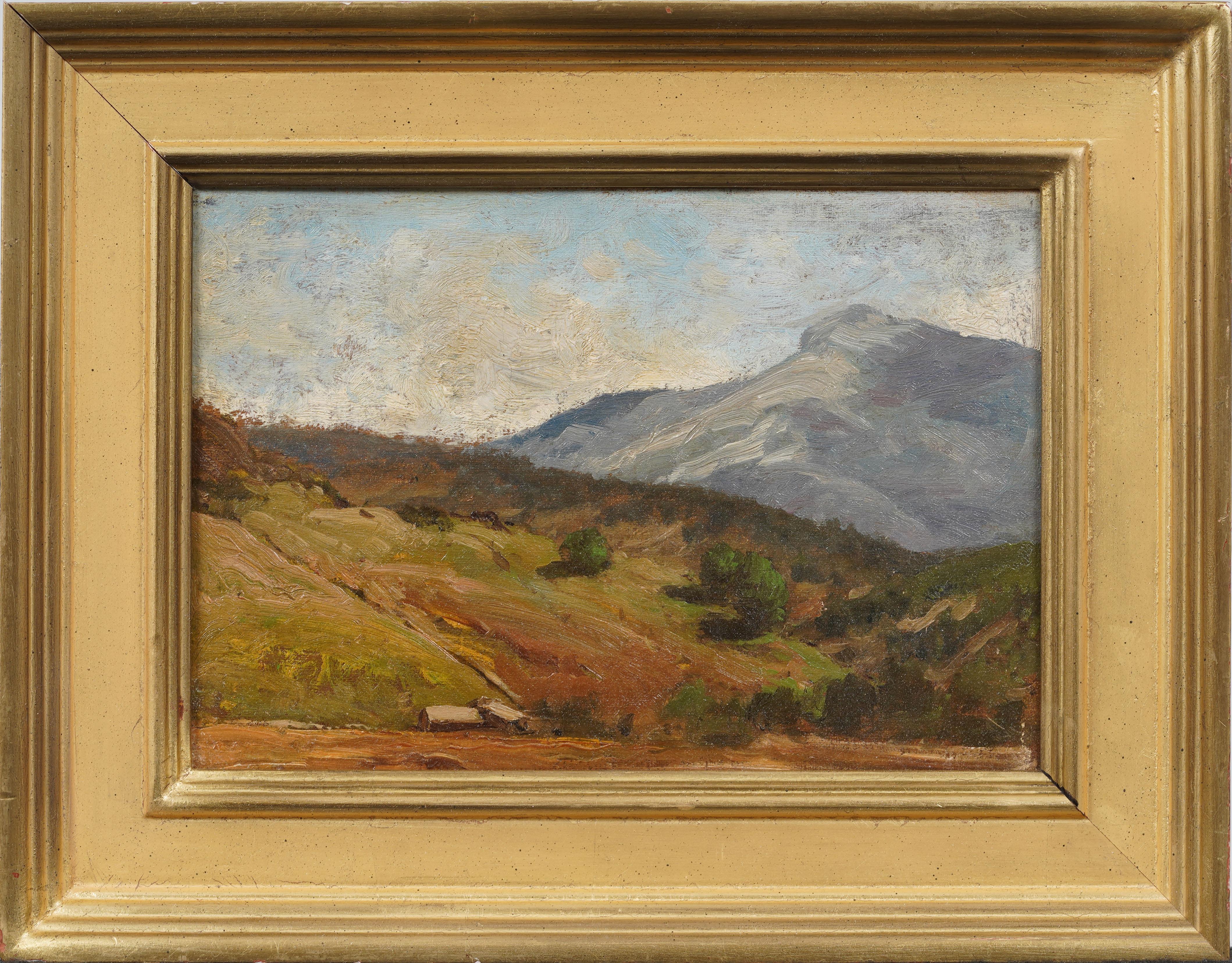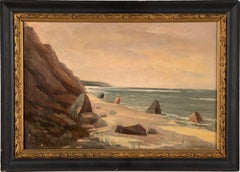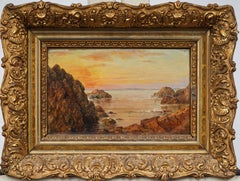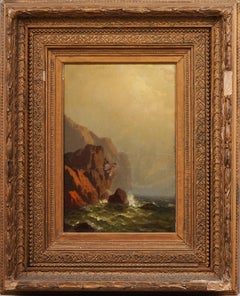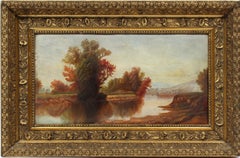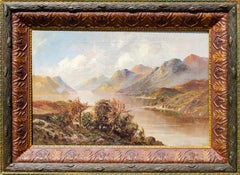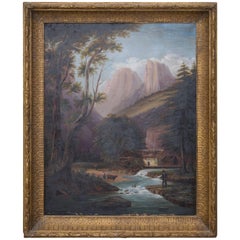Articles similaires à Ancienne peinture à l'huile américaine de la Hudson River School représentant un paysage de plage côtière
Vous voulez plus d'images ou de vidéos ?
Demander au vendeur plus d'images ou de vidéos
1 sur 13
William HustonAncienne peinture à l'huile américaine de la Hudson River School représentant un paysage de plage côtière1870
1870
10 285,42 €
12 856,78 €20 % de remise
À propos de cet article
Impressive early American modernist abstract oil painting. Framed. Oil on canvas. Signed. Image size, 9.25H by 15L. Artist Bio: This following biography was researched, compiled, and written by Geoffrey K. Fleming, Executive Director, Huntington Museum of Art, Huntington, WV.
WILLIAM HUSTON (June 4, 1832 – March 10, 1920)
Landscape and still life painter in oil and watercolor. Born in Pennsylvania, the son of Hannah West (1795 – 1893) and Dr. Robert Mendenhall Huston (1795 – 1864). His father was a prominent physician, served as the president of the Philadelphia Medical Society and was a professor of materia medica and therapeutics at Jefferson Medical College. In 1850 the family resided in Blockley Township, Philadelphia County, Pennsylvania.
The Huston family were Quakers, and it would make sense that Huston attended a Friend’s school, at least in his youth. Where he may have done his artistic training is currently a mystery. It is possible that he studied at the Pennsylvania Academy of the Fine Arts, or perhaps with an already established painter working in Philadelphia.
What is clear is that his father’s death in 1864 would have provided a substantial inheritance that would allow Huston the ability to follow whatever profession he desired, regardless of its success. In 1859 he married his wife, Almira Rodgers (c. 1839 – 1930), in Philadelphia, with whom he had nine children, at least seven of whom lived to adulthood.
By the late 1860s Huston had moved his growing family to the village of Newtown, Queens County, Long Island, New York. There, he worked as an artist while his comfortable position allowed him to employ his own manservant. Though it is not exactly clear when, but certainly by the late 1870s, he had moved his large family to the village of Patchogue, Suffolk
County, Long Island, New York. Located along Great South Bay, the coastal scenery made it an ideal location for an artist to work. Many of the paintings Huston completed of Long Island during this period were featured in exhibitions at the National Academy. In 1885 local papers noted that his residence was “being overhauled and painted,” and in 1888 Huston was recorded as occupying one of “the cottages of J. L. B. Norton” along Central Avenue in Patchogue.
In addition, his still life oils were gaining attention as well, including at the exhibition of ‘studies and sketches’ held in 1882 at the American Art Galleries in New York City. One reviewer who attended the exhibition noted that “William Huston sends studies of fine quality of grapes and pears…” He also contributed works to the American Art Association’s “Prize Fund Exhibitions” that began to be held regularly at the American Art Galleries. At the Fund exhibition in 1885 he showed the work “Afternoon on Long Island Sound,” which was illustrated in the catalog and sold early on in the exhibition. This painting was replaced by the work “Preparing for Market” when the exhibition traveled to Boston in 1886. At the time, his New York City studio was located at 2 West 14th Street.
The South Side Signal of Babylon, New York, remarked on Huston’s recent works in 1886: “William Huston, our local artist, has recently completed two striking oil paintings, which are to be displayed at the second exhibition of the American Art Association, to be held in New York city this month. The titles of the pictures are ‘Asking a Favor’ and ‘Aground at the Mouth of the Creek.’ The pictures are highly creditable to the artist, and we trust they will receive at least one of the prizes offered by the Association.”
At the time of the 1900 U. S. census Huston and his family are listed as residents of Cranford, Union County, New Jersey. Why the family relocated to Cranford remains unknown. Though most of his children were in their twenties and thirties by this stage, records show that almost none of them were employed (except for one son, Clinton), again an indication of family wealth, which certainly only increased upon the death of Huston’s mother in 1893.
During this period the majority of Huston’s works began depicting scenes along the New England coast, such as Sakonnet, Rhode Island (located near Newport), and the Nahant coast of Massachusetts. This seems to indicate that he was spending more time in or near those locations, possibly the majority of his summers. In addition he traveled to Maine, as was noted in New York papers in 1897, where it was reported that he and his wife “… have returned to their home in Cranford, after spending their summer near Portland, [Maine].”
In his last years, Huston exhibited at the Salmagundi Cub in New York City, where he was made a member in 1900. He and his wife moved to Dumont, Bergen County, New Jersey by 1910, where they resided with several of their children. By this point in time William Huston was listed as “artist – retired,” while at least two of his sons were finally employed.
William Huston died in Dumont, New Jersey, on Wednesday, the 10th of March 1920 at the age of eighty-seven. His death was reported in Philadelphia newspapers, which noted that the funeral would be at the “convenience of family.” While much of the rest of his family are buried in the Laurel Hill Cemetery in Philadelphia, the location of Huston’s grave remains a mystery, though he may be buried near where he died in northern New Jersey.
Huston exhibited sporadically during his career, possibly due to his secure financial position, which made being a more active participant unnecessary. Most of the works that have appeared on the market have been coastal scenes either identified with Long Island or New England. In addition, a number of very fine still-lifes and at least one general landscape entitled “Winter,” which was shown at the Salmagundi Club, are known. The majority of his Long Island views appear to date between the late 1860s and the early 1890s.
The identified Long Island oils that he exhibited at the National Academy during the 1880s had very specific titles, including “Fishing Station, Great South Bay,” “Menhaden Oil Works, Great South Bay,” “On Patchogue Creek, L.I.,” “Low Tide, Great South Bay, L.I.” and “The Old Grist Mill, Patchogue, L.I.” In addition, other identified Long Island scenes are known as previously mentioned above, including a view of Jones Creek, located near Massapequa, and a view of Montauk Point. In 2006 a previously unrecorded oil titled “View of Plumb Gut, Long Island Sound, New York” was offered at auction. The title used for the painting was not inscribed in a period hand on the work, and the scene cannot be identified as this location (these types of rock formations at Plum Island are not present along the Gut), though the painting may depict “The Race” (A.K.A. “The Sluiceway”), the body of water between the eastern end of Plum Island and the western end of Great Gull Island.
Huston’s works have remained popular at galleries over the years and have been included in a number of exhibitions regarding Long Island art. In 1981 one of his paintings was chosen for inclusion in the landmark exhibition "The Long Island Landscape 1865-1914," which was held at the Parrish Art Museum in Southampton, New York.
Though there are undoubtedly other exhibitions in which Huston participated, those presently known include the following: National Academy of Design, New York, NY, 1875, 1882, 1885, 1886; American Art Galleries, New York, NY, 1882, Manufacturers’ and Mechanics’ Institute Art Exhibition, Boston, MA, 1882; Brooklyn Society of Artists, Brooklyn, NY, 1883-84; American Art Association’s “Prize Fund Exhibition” at American Art Galleries, New York, NY, 1885; Southern Exposition, Louisville, KY, 1885; American Art Association, New York, NY, 1886; American Art Association’s “Prize Fund Exhibition” at the Boston Museum of Fine Arts, Boston, MA, 1886; Queens County Fair, Mineola, NY, 1890; Salmagundi Club, New York, NY, 1900-1905, 1907.
Huston’s works are known to be in the following public institutions at present: Long Island Museum of Art, History and Carriages, Stony Brook, NY. The majority of his works reside in private collections throughout the United States.
- Créateur:William Huston (1832 - 1920, Américain)
- Année de création:1870
- Dimensions:Hauteur : 40,64 cm (16 po)Largeur : 55,88 cm (22 po)Profondeur : 5,08 cm (2 po)
- Support:
- Mouvement et style:
- Période:
- État:
- Adresse de la galerie:Buffalo, NY
- Numéro de référence:1stDibs : LU139214895932
À propos du vendeur
4,9
Vendeur Or
Vendeurs premium dont la note est supérieure à 4,3 et le délai de réponse de 24 heures maximum
Établi en 1970
Vendeur 1stDibs depuis 2015
3 052 ventes sur 1stDibs
Temps de réponse habituel : 5 heures
- ExpéditionRecherche du devis...Expédition depuis : Brooklyn, NY
- Politique des retours
Certaines parties de cette page ont été traduites automatiquement. 1stDibs ne garantit pas l'exactitude des traductions. L'anglais est la langue par défaut de ce site web.
Garantie d'authenticité
Bien qu'il soit peu probable que la situation se présente, dans le cas où vous rencontreriez un problème d'authenticité d'un article, contactez-nous dans un délai d'un an pour obtenir un remboursement intégral. DétailsGarantie de remboursement
Si votre article n'est pas conforme à la description, est endommagé pendant le transport ou ne vous est pas livré, contactez-nous sous 7 jours pour obtenir un remboursement intégral. DétailsAnnulation sous 24 heures
Vous disposez d'un délai de 24 heures pour annuler votre achat sans motif.Des vendeurs professionnels agréés
Nos vendeurs de renommée mondiale doivent respecter des normes strictes en matière de service et de qualité, afin de préserver l'intégrité de nos fiches produit.Garantie d'alignement des prix
Si vous constatez qu'un autre vendeur a mis en vente le même article à un prix inférieur sur un autre site, nous nous alignerons sur ce prix.Livraison en toute confiance à l'international
Notre réseau de transporteurs de premier ordre propose des options d'expédition spécialisées dans le monde entier, y compris des livraisons personnalisées.Plus d'articles de ce vendeur
Tout afficherAncienne peinture à l'huile impressionniste américaine de l'Hudson River School représentant un paysage marin côtier
Antique impressionist painting of a coastal seascape. Oil on canvas, circa 1900. Signed illegibly. Encadré. Image size, 18L x 12H.
Catégorie
années 1890, Hudson River School, Peintures - Paysage
Matériaux
Toile, Huile
650 € Prix de vente
25 % de remise
Peinture ancienne de l'école de l'Hudson River Luminous Coastal Sunset Seascape
Signé et daté K.W. Whiting 1881, ce paysage marin lumineux du peintre américain Kate White Whiting (1840-1917) capture une scène côtière spectaculaire au coucher du soleil avec une t...
Catégorie
années 1880, Hudson River School, Peintures - Paysage
Matériaux
Huile, Planche
Peinture à l'huile ancienne encadrée de l'école de la rivière Hudson, paysage marin lumineux et côtier
Antique American Hudson River School coastal seascape. Most likely a view of Maine. Oil on board. Image size, 8 by 12 inches.
Catégorie
années 1870, Hudson River School, Peintures - Paysage
Matériaux
Toile, Huile
2 423 € Prix de vente
20 % de remise
Ancienne et rare peinture à l'huile originale de l'Hudson River School, États-Unis
Une superbe peinture de paysage de l'école de la rivière Hudson du 19e siècle, magnifiquement encadrée dans une exquise moulure en bois doré d'époque.
Catégorie
années 1890, Hudson River School, Peintures - Paysage
Matériaux
Toile, Huile
833 € Prix de vente
20 % de remise
Antique American Hudson River School Coastal Sunset Seascape Framed Oil Painting
Antique American sunset seascape beach scene oil painting. Oil on board. Framed. Signed. Measuring: 15 by 21 inches overall, and 9 by 15 painting alone.. In excellent original cond...
Catégorie
années 1870, Hudson River School, Peintures - Paysage
Matériaux
Toile, Huile
Ancienne peinture à l'huile de paysage encadrée de l'école de la rivière Hudson en Nouvelle-Angleterre
Une charmante huile sur toile du 19e siècle et du début du 20e siècle représentant un paysage de montagne paisible. Exécutée d'une main libre et impressionniste, l'œuvre représente d...
Catégorie
Début des années 1900, Hudson River School, Peintures - Paysage
Matériaux
Toile, Huile
Suggestions
Original 19th century Antique Oil painting on canvas, seascape, Signed, Framed
Il s'agit d'une peinture à l'huile ancienne sur toile, originale et signée, représentant un paysage marin sombre avec des vagues turbulentes s'écrasant contre un rivage accidenté sou...
Catégorie
Début du XXe siècle, Impressionnisme, Peintures - Paysage
Matériaux
Huile
453 € Prix de vente
20 % de remise
Peinture de style de l'Hudson River School, vers 1900
Sans titre, c.C. 1900
Huile sur toile
16 x 24 in.
Encadré : 22 3/4 x 31 x 2 in.
Signé en bas à droite
Catégorie
Début des années 1900, Hudson River School, Peintures - Paysage
Matériaux
Toile, Huile
Paysage de l'école de la rivière Hudson Huile sur toile, 19e siècle
Ce paysage américain intact est un parfait exemple de l'école de la rivière Hudson au XIXe siècle. Le caractère folklorique de la scène peut indiquer que le peintre était européen, a...
Catégorie
Antiquités, Milieu du XIXe siècle, Américain, Autre, Peintures
Ancienne peinture à l'huile américaine signée, paysage côtier, scène de plage et Cliffs
Scène côtière
par Herbert J. Day (1875-1950)
huile sur toile signée, encadrée
encadré : 21 x 27.5 pouces
toile : 16 x 22.5 pouces
provenance : collection privée, UK
état : très bon e...
Catégorie
Début du XXe siècle, Victorien, Peintures - Paysage
Matériaux
Huile
934 € Prix de vente
20 % de remise
Ancienne peinture de paysage côtier de bord de mer encadrée
Magnifique peinture ancienne à l'huile sur panneau, encadrée à la main, représentant un paysage côtier ou marin.
États-Unis d'Amérique, début du 20e siècle
Mesures : 9,63 "W x 1 "D...
Catégorie
Début du 20ème siècle, Américain, Country, Peintures
Matériaux
Bois, Peinture
763 € Prix de vente
20 % de remise
Huile sur carton d'une scène côtière du New Hampshire
Huile sur carton d'une scène côtière du New Hampshire. Signé au dos par l'artiste James Rostron du New Hampshire. Daté de 1940 Mount Cranmore North Conway, New Hampshire.
Les dimens...
Catégorie
Vintage, années 1940, Peintures
Matériaux
Bois, Massonite, Peinture
